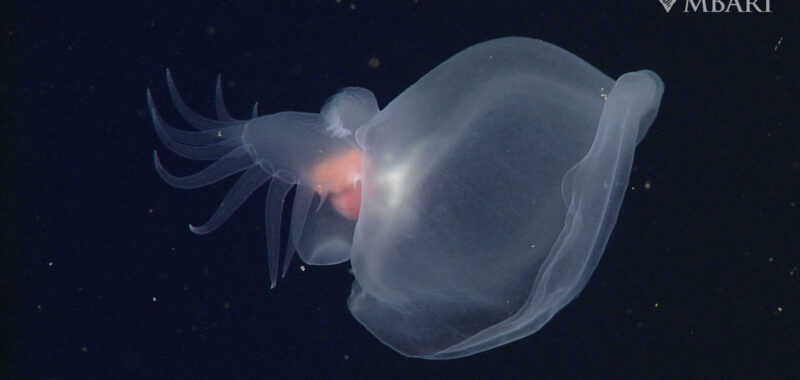Marine biologists have found a new sea slug that is right at home in the ocean’s deep and dark midnight zone. With a large, gelatinous hood, tail like a paddle, and bright bioluminescence Bathydevius caudactylus is so unique that it belongs to a whole new family of sea slugs. The animal nicknamed the “mystery mollusc” is described in a study published in the December 2024 issue of the journal Deep-Sea Research.
[Related: This dashing tropical sea slug just showed up in the UK.]
Spotting the mystery mollusc
The team from the Monterey Bay Aquarium Research Institute (MBARI) first spotted this mystery mollusc over 20 years ago, while using the remotely operated vehicle Tiburon offshore at 8,576 feet deep. They saw this strange creature more than 150 times over the next two decades.
Initially, they had trouble placing the mystery mollusc in a known group because Bathydevius caudactylus looks unlike anything they had seen before. It has a voluminous hooded structure at one end, a flat tail that’s fringed with several finger-like projections at the other, and lots of colorful internal organs in between. However, it has a foot like a snail, which is where the nickname mystery mollusc comes from.

After collecting a specimen, they brought it back to the lab for a closer look. They investigated its anatomy and genetics and confirmed that it is a nudibranch–aka a sea slug.
Most nudibranchs live along the seafloor. They are also common in many coastal environments, including coral reefs, kelp forests, and tide pools and a small number of sea slug species are known to live on the abyssal seafloor–between 9,800 and 19,700 feet deep. A few are considered pelagic and live in open waters near the surface.
Bathydevius caudactylus is the first known sea slug to live in the deep water column. It lives in the ocean’s midnight zone–a wide area of open water about 3,300 to 13,100 feet below the surface.
Currently, this hoodled mollusc is known to live in the waters offshore of North America’s Pacific coast. MBARI scientists have spotted it as far north as Oregon and as far south as Southern California. Researchers from NOAA spotted a similar-looking animal in the
Mariana Trench in the Western Pacific, suggesting that it could have an even bigger distribution.
Food, safety, and company
According to the team, Bathydevius caudactylus has evolved some unique solutions to find food, safety, and companions in order to live in the midnight zone.
Most sea slugs use their raspy tongues to feed on prey that is attached to the seafloor. Instead, Bathydevius caudactylus works a bit more like a Venus fly trap. It uses a cavernous hood to trap crustaceans. Some other unrelated deep-sea species–including some jellyfish, tunicates, and anemones–use this feeding strategy.
[Related: The process sea slugs use to regrow severed body parts is surprisingly common.]
Bathydevius caudactylus are typically found in open water far below the surface and far above the seafloor. They flex their bodies up and down to swim or get around by drifting motionless with the currents. To keep from being eaten, they use their transparent bodies to essentially hide in plain sight. They quickly close their oral hoods for a quick escape, similar to the way a jellyfish pulses.
If they are threatened, Bathydevius caudactylus can light up with bioluminescence to both distract and deter hungry predators. In one instance, the team saw it illuminate and then detach a steadily glowing finger-like projection from the tail, likely to distract a potential predator.

“When we first filmed it glowing with the ROV, everyone in the control room let out a loud ‘Oooooh!’ at the same time. We were all enchanted by the sight,” study co-author and MBARI Senior Scientist Steven Haddock said in a statement. “Only recently have cameras become capable of filming bioluminescence in high-resolution and in full color. MBARI is one of the only places in the world where we have taken this new technology into the deep ocean, allowing us to study the luminous behavior of deep-sea animals in their natural habitat.”
Like other nudibranchs, Bathydevius caudactylus is a hermaphrodite and has both male and female sex organs. It appears to descend to the seafloor to spawn. The team observed some animals using their muscular foot to attach to the muddy seafloor so that they could release their eggs.

CREDIT: MBARI.
VIDEO CREDIT: MBARI.
A detailed examination of the specific gene sequences confirmed that Bathydevius caudactylus is unique enough from other known sea slugs to be a member of a new family, Bathydeviidae. While two shallow-water sea slugs also use a hood to capture prey, this appears to be a convergent evolution of a similar feeding method. Bathydevius caudactylus is only distantly related to these species and genetic analysis suggests that it may have split off first on its own branch of the sea slug family tree.
“What is exciting to me about the mystery mollusc is that it exemplifies how much we are learning as we spend more time in the deep sea, particularly below 2,000 meters [6,551 feet],” said Haddock. “For there to be a relatively large, unique, and glowing animal that is in a previously unknown family really underscores the importance of using new technology to catalog this vast environment. The more we learn about deep-sea communities, the better we will be at ocean decision-making and stewardship.”

